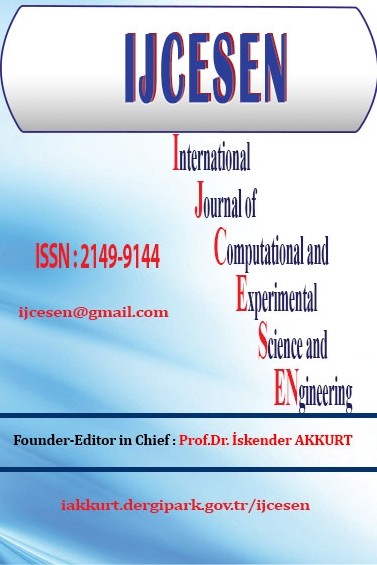Effect of Kaolinite Mass Ratio on Compressive Strength of Kaolinite-Calcite Based Geopolymer
Effect of Kaolinite Mass Ratio on Compressive Strength of Kaolinite-Calcite Based Geopolymer
Geopolymers, Compressive strength, Kaolinite Calcite, Curing temperature,
___
- [1] Villa, C., E.T.Pecina, R.Torres, L.Gomez “Geopolymer synthesis using alkaline activation of natural zeolite” Construction and Building Materials. 24 (2010) 2084-2090 [2] Beycioğlu, A., C.Başyiğit “Rule-Based Mamdani-Type Fuzzy Logic Approach to Estimate Compressive Strength of Lightweight Pumice Concrete” ACTA PHYSICA POLONICA A. 128(2B) (2015) 424-426 [3] Kusak, I., M.Lunak, P.Rovnanik “Electric conductivity changes in geopolymer samples with added carbon nanotubes” Procedia Engineering 151 ( 2016 ) 157 – 161 [4] Heah, C., Y., H Kamarudin, A.M.Mustafa Al Bakri, M.Bnhussain, M. Luqman, I.Khairul Nizar, C.M.Ruzaidi Y.M.Liew “Study on solids-to-liquid- and alkaline activator ratios on kaolin-based geopolymers” Construction and Building Materials. 35 (2012) 912–922 [5] Autef, A., E.Joussein, G.Gasgnier, S.Pronier, I.Sobrados, J.Sanz, S. Rossignol “Role of metakaolin dehydroxylation in geopolymer Synthesis” Powder Technology. 250 (2013) 33–39 [6] Lee, N., K., E.M.Kim, H.K.Lee “Mechanical properties and setting characteristics of geopolymer mortar using styrene-butadiene (SB) latex” Construction and Building Materials. 113 (2016) 264–272 [7] Mijarsh, M., J., A., M.A.Megat Johari, Z.A.Ahmad “Synthesis of geopolymer from large amounts of treated palm oil fuel ash: Application of the Taguchi method in investigating the main parameters affecting compressive strength” Construction and Building Materials 52 (2014) 473–481 [8] Alshaaer, M., B.El-Esweed, R.I.Yousef, F.Khalili, H.Rahier “Development of functional geopolymers for water purification, and construction purposes” Journal of Saudi Chemical Society. 20 (2016) 85–92 [9] Alshaaer, M. “Two-phase geopolymerization of kaolinite-based geopolymers” Applied Clay Science. 86 (2013) 162–168 [10] Fiocco, L., B.Michielsen, E.Bernardo “Silica-bonded apatite scaffolds from calcite-filled preceramic polymers” Journal of the European Ceramic Society. 36 (2016) 3211–3218 [11] Provis, J., L., P.Duxson, J.S.J.Van Deventer, G.C.Lukey “The Role of Mathematical Modelling and Gel Chemistry in Advancing Geopolymer Technology” Chemical Engineering Research and Design. 83 (2005) 853-860
- Yayın Aralığı: 4
- Başlangıç: 2015
- Yayıncı: Prof.Dr. İskender Akkurt
Experimental Investigation of a Novel Condensing Boiler
Effect of Kaolinite Mass Ratio on Compressive Strength of Kaolinite-Calcite Based Geopolymer
Response Surface Based Optimization of Aerodynamic Performance of a Horizontal Axis Wind Turbine
Design of low power DTMOS based FCS and its notch filter application for ECG signals
Hatice Gül UGRANLI, Melih YILDIRIM, Fırat KAÇAR
Experimental Study for the Energy Levels of Europium by the Clinic LINAC
Nilgün DEMİR, Ayşe KIVRAK, Mahmut ÜSTÜN, Alp CESUR, İsmail BOZTOSUN
Investigation of notch effect on vibration behavior of filled and unfilled composite beam
Nadjet TAOUALIT, İsmail ABIDAT, Djamal-eddine HADJ-BOUSSAAD
Open-Hole Tensile Experiments of Thermoplastic Composite Laminates and Finite Element Analysis
Hakkı ÖZER, Orhan KURTULUŞ, Harun GÜÇLÜ, Mustafa TAŞ, Murat YAZICI
